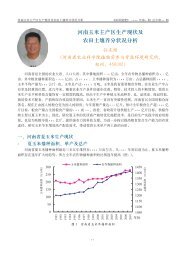Better Crops 2004 #2 - International Plant Nutrition Institute
Better Crops 2004 #2 - International Plant Nutrition Institute
Better Crops 2004 #2 - International Plant Nutrition Institute
You also want an ePaper? Increase the reach of your titles
YUMPU automatically turns print PDFs into web optimized ePapers that Google loves.
Will We Run Out of Phosphorus?<br />
By David W. Dibb<br />
The question occasionally arises as to whether the world will eventually use all the<br />
supply and reserves of an essential nutrient such as phosphorus (P). This article<br />
gives a brief explanation of why there is no danger of running out of P sources.<br />
Will we run out of P fertilizer for<br />
food production? The short and<br />
definitive answer is “no.” How<br />
can that assertion be absolute? Phosphorus<br />
is one of the most abundant basic mineral<br />
elements on the earth. Phosphorus is a<br />
necessary component for all living organisms.<br />
The form of P can be changed, the<br />
location can be changed, but the total mass<br />
(the total existing amount of P) is unchanged.<br />
The availability of P for use in food<br />
production…and thus availability to living<br />
organisms…depends on our ability to recover<br />
P from wherever it resides and place<br />
it near the plants that produce food and<br />
become the energy source for all living<br />
things…in a form plants can use.<br />
Currently<br />
ently, , there e is abundant P avail-<br />
able to produce food. In large part, this is<br />
because we have learned to extract P from<br />
large mineral phosphate rock deposits,<br />
convert it to a form that is more available<br />
to plants, and deliver it to farmers, who<br />
Concentrat<br />
ated<br />
phosphate rock deposits are the main<br />
source of P fertilizers today.<br />
apply the P to their crops and produce our<br />
food. This process is the foundation of the<br />
current commercial P fertilizer industry.<br />
Some of the P we need to make our<br />
bodies function properly comes to us directly<br />
in vegetables, fruits, grains, etc. Some<br />
comes to us indirectly through animal products<br />
such as meat, milk, and eggs. Some is<br />
consumed in vitamin or mineral supplements.<br />
All of this P originally came from<br />
one of the naturally occurring mineral P<br />
deposits…whether from the sources that<br />
were concentrated in phosphate rock deposits,<br />
or from those diffused in soils during<br />
their natural development processes. As<br />
crops are grown and as P is removed from<br />
soils, P has to be replaced to sustain the<br />
potential to produce more food. This replacement<br />
represents the current practice<br />
of crop fertilization.<br />
But, what about when all of these mineral<br />
deposits we are mining are depleted?<br />
Will that happen soon? When it does, will<br />
we run out of P for food production? Again,<br />
the definitive answer is “NO<br />
NO.” To understand<br />
why, we need to take a look at historical<br />
uses and sources of P for food production,<br />
what is happening today, the current<br />
reserves of P, and some possible other<br />
sources of P for the future. With this perspective,<br />
we will be able to understand why<br />
the world will not run out of P.<br />
First, consider the historical use of P<br />
in food production.<br />
We all know the story<br />
of how the Native Americans showed the<br />
early Pilgrims in colonial times how to put<br />
a fish in the hole where corn seeds were<br />
planted in order to produce more abundant<br />
crops. As the fish decomposed, needed P<br />
<strong>Better</strong> <strong>Crops</strong>/Vol. 88 (<strong>2004</strong>, No. 2) 3

















